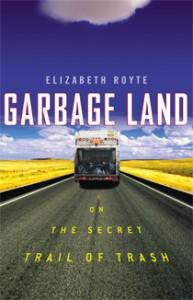 While writing a post on biochar, I came across a book I read a few years back. After having written a review of Animal, Vegetable, Miracle two years post-reading, I figured I’d write a review of Elizabeth Royte’s Garbage Land: On the Secret Trail of Trash as well. Despite the fact that I read it a few years back, I often find myself referring to back to this exposĂŠ. Written in 2005, Royte’s look into the waste industry provides an inside view of what happens to trash once it leaves our homes.
While writing a post on biochar, I came across a book I read a few years back. After having written a review of Animal, Vegetable, Miracle two years post-reading, I figured I’d write a review of Elizabeth Royte’s Garbage Land: On the Secret Trail of Trash as well. Despite the fact that I read it a few years back, I often find myself referring to back to this exposĂŠ. Written in 2005, Royte’s look into the waste industry provides an inside view of what happens to trash once it leaves our homes.
Royte, a journalist who lived in Brooklyn at the time she wrote the book, follows the flow of her waste. Throughout the book there are three major waste streams, trash (as in solid waste picked up by the municipality), sewage (leaving through the pipes), and recyclables. The book opens with Royte paddling down the Gowanus Canal, a stream strewn with trash. In fact, the Gowanus is now an EPA superfund site. Due to “years of discharges, storm water runoff, sewer outflows and industrial pollutants, the Gowanus Canal has become one of the nation’s most extensively contaminated water bodies. Contaminants include PCBs, coal tar wastes, heavy metals and volatile organics.”
Perhaps the most eye-opening aspect of Royte’s book is the fact that we have become so far removed from our waste in the first place. The sheer amount of trash generated by each person in the United States has increased to roughly 4.5 pounds per day. Because of the rather efficient waste disposal system, and the cheap dumping rates in many cities, there is little to no incentive to reduce the amount of trash we produce.
In addition to looking at where waste goes, Garbage Land delves into waste diversion efforts as well. Compost, recycling, and zero waste movements are each given their own chapters. As a demonstration of Royte’s sense of humor, the chapter on plastics is titled “Satan’s Resin.” Overall the book is both informational and intriguing. The writing kept my attention on a subject that could have easily gotten stale.
Quickly thumbing through the index reveals the thoroughness and depth of Royte’s research. In addition, the back of the book contains a discussion guide and interview with the author. Royte also provides a number of books for further reading, including Cradle to Cradle, one of the first books reviewed on 2nd Green Revolution.
[Image source]

